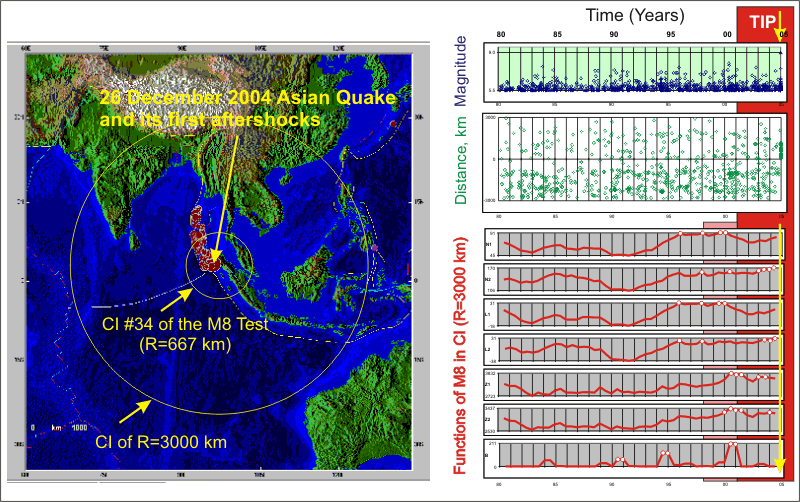The 26 December 2004, Mw9.0 (Ms8.8) Great Asian mega-thrust earthquake off the west coast of Northern Sumatra, requires special comment:
The linear dimension of its source is about 1000-1300 km, i.e., about the diameter of Circles of Investigation used in the Global Test of M8 to predict M8.0+ earthquakes. The source length of the earthquakes predicted in the time interval 1985-2003 is usually between 150 and 400 km. Therefore, since the logic of our methodology suggests that the area of investigation should be about 5-10 times larger than the target earthquake size, it would be naive to expect monitoring designed for either M8.0+ or M7.5+ earthquakes to predict the 26 December 2004 event. According to the M8 algorithm predictions we were not expecting any M8.0+ or M7.5+ events in the Indian Ocean during the second half of 2004.
If on July 1, 2004 someone had been sufficiently ambitious to extend application of the M8 algorithm into the uncalibrated magnitude range targeting M9.0+ earthquakes, he or she would have diagnosed Time of Increased Probability in advance of the 2004 Great Asian Quake. The M8 computer code run with the target earthquake magnitude threshold of 9.0 and the radius of CI's of 3000 km establishes a current alarm. The figure below shows on the left the CI #34, centered at (3.00N, 97.00E), its zoom to 3000-km radius, along with the epicenter and first aftershocks of the 26 December 2004, Mw9.0, while on the right - the magnitude, location, and the values of the M8 functions versus time. As can be seen the current TIP expires by December 2005.
The December 26 event seems to be the first indication that the algorithm, designed for prediction of M8.0+ earthquakes can be rescaled for prediction of both smaller magnitude earthquakes (e.g., down to M5.5+ in Italy) and for mega-earthquakes of M9.0+. The event is not full verification, but it is very important for general understanding of our methodology and the Problem of Earthquake Prediction.
The extent of the M8 algorithm M9.0+ TIPs in space and time is thought provoking. There was one cluster of TIPs in 1984-1989 around western Mediterranean (a compact union of eight out of the 262 CI's) and another one in 1994-1999 around the Cascadia subduction zone (a compact union of the five CI's off coast of the western U.S.). Neither of these produced an M9.0+ event. The union of TIPs now has a global extent (124 CI's are in alarm).
The other relevant observation is that all four mega-earthquakes of the 20th century (Kamchatka, 1952/11/04, Mw9.0; Andreanoff Islands, 1957/03/09, Mw9.1; Chile, 1960/05/22, Mw9.5; Alaska, 1964/03/28, Mw9.2) happened within a narrow interval of time. Such a cluster is unlikely with a 99% confidence for uniformly distributed independent events. Since good evidence suggests that seismic events including mega-earthquakes cluster, it is possible that we will have further confirmation of M8 prediction within 5-10 years in other regions.
The linear dimension of its source is about 1000-1300 km, i.e., about the diameter of Circles of Investigation used in the Global Test of M8 to predict M8.0+ earthquakes. The source length of the earthquakes predicted in the time interval 1985-2003 is usually between 150 and 400 km. Therefore, since the logic of our methodology suggests that the area of investigation should be about 5-10 times larger than the target earthquake size, it would be naive to expect monitoring designed for either M8.0+ or M7.5+ earthquakes to predict the 26 December 2004 event. According to the M8 algorithm predictions we were not expecting any M8.0+ or M7.5+ events in the Indian Ocean during the second half of 2004.
If on July 1, 2004 someone had been sufficiently ambitious to extend application of the M8 algorithm into the uncalibrated magnitude range targeting M9.0+ earthquakes, he or she would have diagnosed Time of Increased Probability in advance of the 2004 Great Asian Quake. The M8 computer code run with the target earthquake magnitude threshold of 9.0 and the radius of CI's of 3000 km establishes a current alarm. The figure below shows on the left the CI #34, centered at (3.00N, 97.00E), its zoom to 3000-km radius, along with the epicenter and first aftershocks of the 26 December 2004, Mw9.0, while on the right - the magnitude, location, and the values of the M8 functions versus time. As can be seen the current TIP expires by December 2005.

The December 26 event seems to be the first indication that the algorithm, designed for prediction of M8.0+ earthquakes can be rescaled for prediction of both smaller magnitude earthquakes (e.g., down to M5.5+ in Italy) and for mega-earthquakes of M9.0+. The event is not full verification, but it is very important for general understanding of our methodology and the Problem of Earthquake Prediction.
The extent of the M8 algorithm M9.0+ TIPs in space and time is thought provoking. There was one cluster of TIPs in 1984-1989 around western Mediterranean (a compact union of eight out of the 262 CI's) and another one in 1994-1999 around the Cascadia subduction zone (a compact union of the five CI's off coast of the western U.S.). Neither of these produced an M9.0+ event. The union of TIPs now has a global extent (124 CI's are in alarm).
The other relevant observation is that all four mega-earthquakes of the 20th century (Kamchatka, 1952/11/04, Mw9.0; Andreanoff Islands, 1957/03/09, Mw9.1; Chile, 1960/05/22, Mw9.5; Alaska, 1964/03/28, Mw9.2) happened within a narrow interval of time. Such a cluster is unlikely with a 99% confidence for uniformly distributed independent events. Since good evidence suggests that seismic events including mega-earthquakes cluster, it is possible that we will have further confirmation of M8 prediction within 5-10 years in other regions.